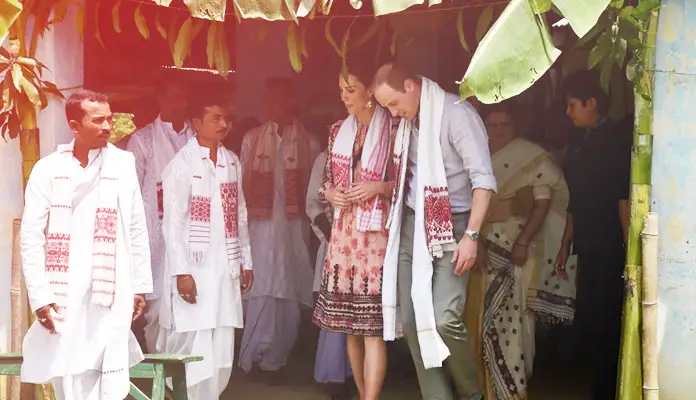The Gamusa/Gamosa/Gamocha is an article of great significance for the people of Assam and the very symbol of Assamese culture. It is generally a white hand-woven piece of cloth of cotton or silk of around 2 feet in width and 5 feet in length, with red woven patterns or motifs on two sides and red stripes on the long border.
Here are 5 facts you must know about gamosa.
1. Origin of The Name

Literally translated, it means ‘something to wipe the body with’ (Ga=body, mosa=to wipe) however, interpreting the word gamosa as the body-wiping towel is misleading. The word gamosa is derived from the Kamrupi word gaamasa (gaama+chadar), the cloth used to cover the Bhagavad Purana at the altar.
2. Origin of Usage
The gamosa has a very old history. Its for sure that this is not something which was incorporated from any other part of the India. According to Dr. Lila Goigoi, Gamosa has been used since the Ahom Kingom. According to the book “A History Assam” by Edward Gait the price of one gamosa during 1739 was around 6 paisa.
3. Usage of Gamosa

Though it may be used daily to wipe the body after a bath (an act of purification), the use is not restricted to this. here is the other main usage of gamosa
- It is used to cover the altar at the prayer hall or cover the scriptures. An object of reverence is never placed on the bare ground, but always on a gamosa.
- It is used by the farmer as a waistcloth (tongali) or a loincloth (suriya)
- A Bihu dancer wraps it around the head with a fluffy knot.
- It is hung around the neck at the naamghar (prayer hall) and was thrown over the shoulder in the past to signify social status.
- Guests are welcomed with the offering of a gamosa and tamul (betel nut)
- Elders are offered gamosas which referred to as bihuwaan in this case, during Bihu.
SO, one can, therefore, very well say, that the gamosa symbolizes the life and culture of Assam.
3. Types of Gamosa
According to the usage, there are different types of Gamosa.
- Paani Gamosa
- Tamul Gamosa
- Bihuwan
Again, there is one another kind of gamosa you will find in lower Assam that is “Anakata”. This is that kind of gamosa which is taken out from the tatxal without cutting. They generally use these on special occasions like marriage etc.
4. Cultural Significance

Significantly the gamosa is used equally by all irrespective of religious and ethnic backgrounds. At par with gamosa, there are beautifully woven symbolic clothes with attractive graphic designs being used by different cultural sub-systems and ethno-cultural groups as well.
5. The Relation of Gamosa with Bihu
There is a special relation of Gamosa with Bihu. The boys wrap gamosa around the head while performing Bihu dance. Also, it’s used at the time of giving respect to the elder one. This kind of gamosa is called bihuwan.

